A codebook from 1701
( )
(
)
( )
)
The Louis XIV's codebooks
- Introduction (introduction)
- The invention of the great chipher (invention)
- Analyse of Louis XIV's codebooks (analyse)
- Cryptanalyse (break)
- Codebooks examples
(examples)
- A codebook from 1643
- A one part codebook from 1676
- A two part codebook from 1676 (the first one?)
- A one part codebook from 1684
- Messages encoded by a two part codebook from 1685
- A two part codebook from 1688
- Messages from 1690, an unpublished codebook?
- The codebook from 1691 broken by Bazeries
- A codebook from 1701
- The Man in the Iron Mask (mask)
Introduction
In the archives of the Bnf (National Library of France), one can access online, on the Gallica site (the Bnf's web showcase) to numerous archives. In the document "Recueil de chiffres diplomatiques (1688-1713)", one can find ciphering and deciphering tables of codebooks of the French government of the time of Louis XIV.
The following deciphering table (the ciphering table is not present) dates from September 14, 1701 and allowed exchanges with Mr d'Usson. Normally a code allows exchanges between two people. Only one is shown here. I presume that the other person is none other than Louis XIV or more generally, his government.
Code Description

(the previous image corresponds to the deciphering table of the code).
In all, the code has 823 cipher groups. The form that contains it can contain 1000 groups.
Here is the structure of this code:
Like the previous codebooks, letters, syllables, frequent words, suffixes and prefixes, proper names, etc. are represented.
The main novelty is the appearance of the numbers: un, deux, trois, ... dix, onze, douze, treize, ... million (one, two, three, ... ten, eleven, twelve, thirteen, ..., million).
The last group number is 830 but 7 groups has no meaning. On the other hand, about twenty groups are scratched. I can't find any explanation... Perhaps the code was intended for another person. When it was given to Mr. Usson, the proper names present no longer had any meaning.
A minor peculiarity: the name of a country and its inhabitants are coded by the same group: France - françois (392), Angleterre - anglois (427), ...
Finally, the word "ennemi" is coded by group 480.
References
- BnF - Gallica - Recueil de chiffres diplomatiques (1688-1713) (Web)